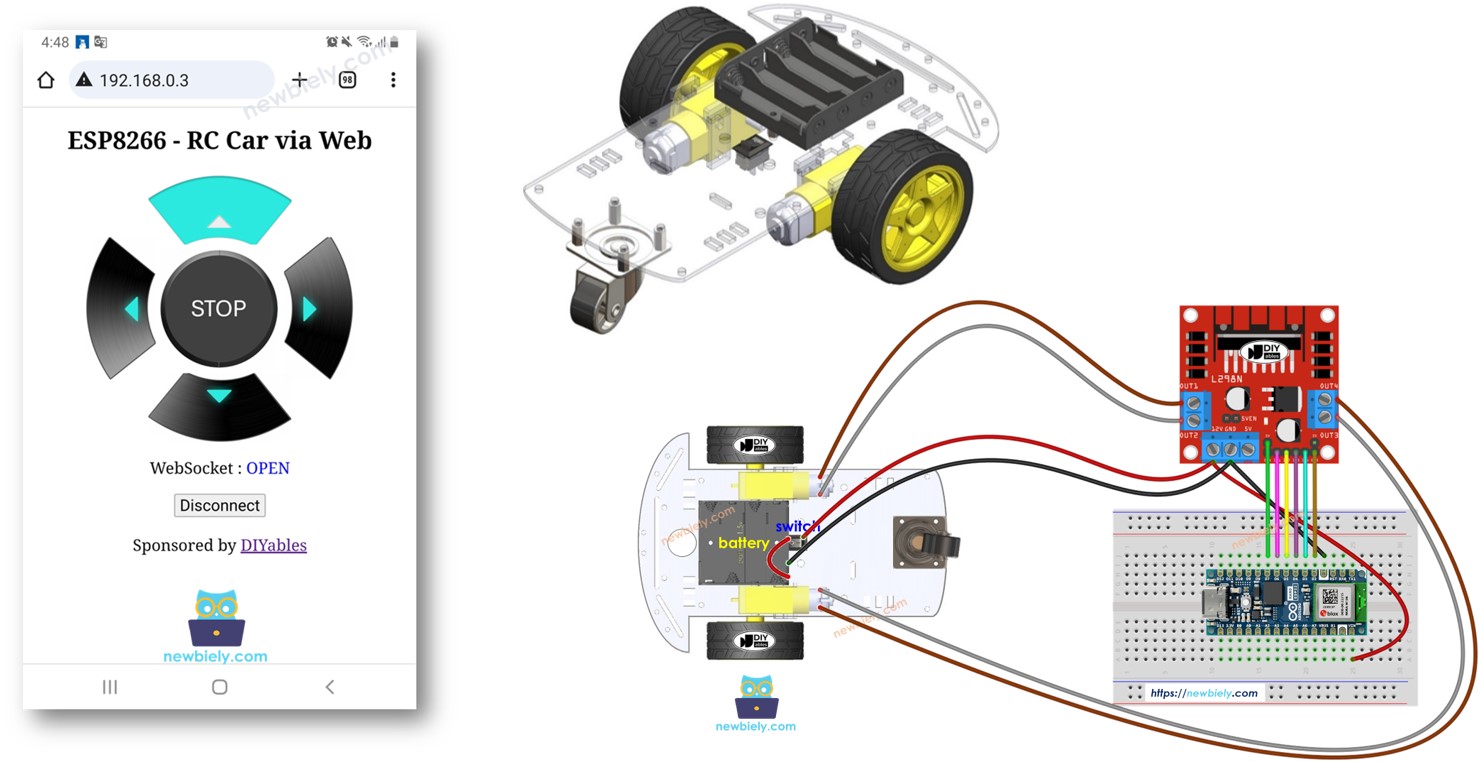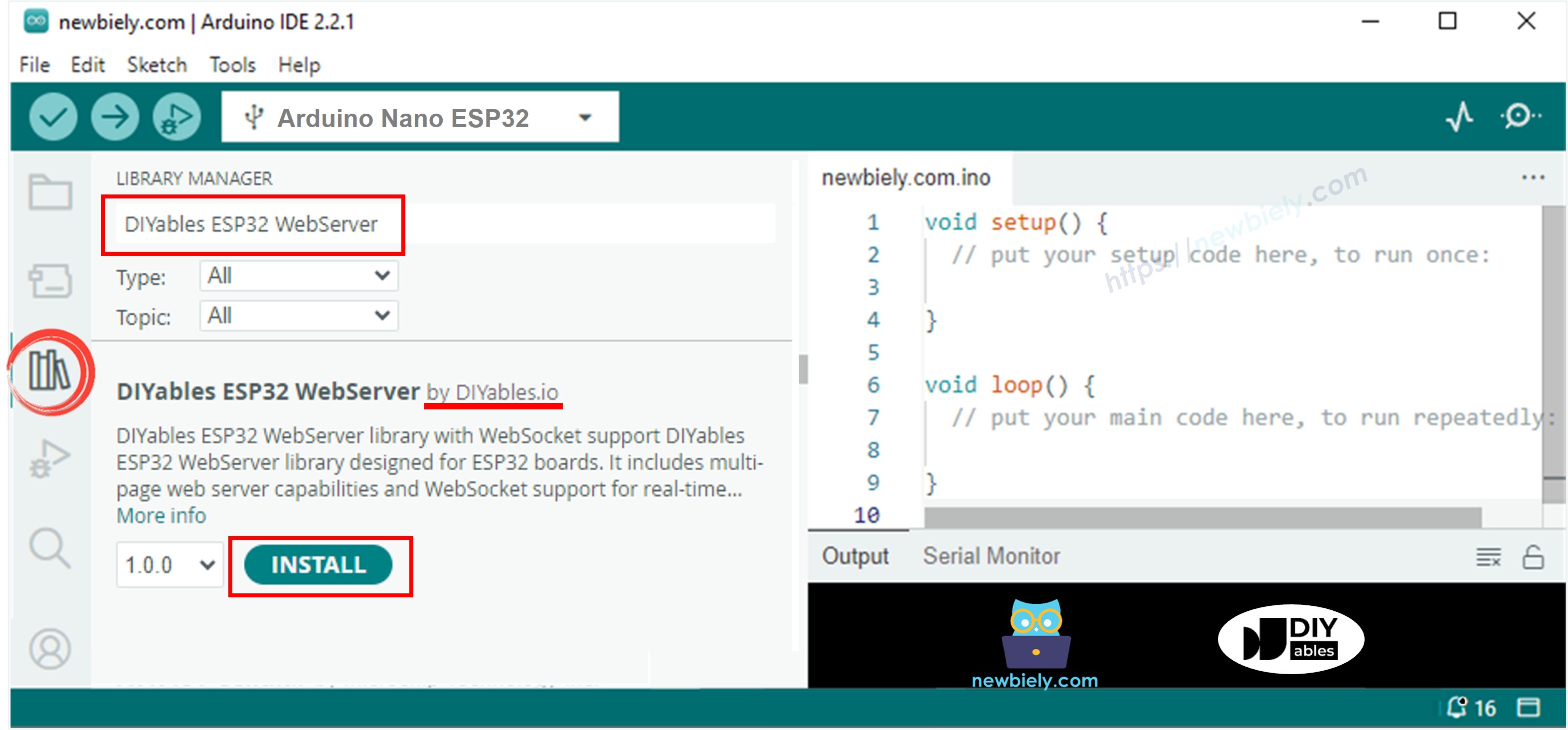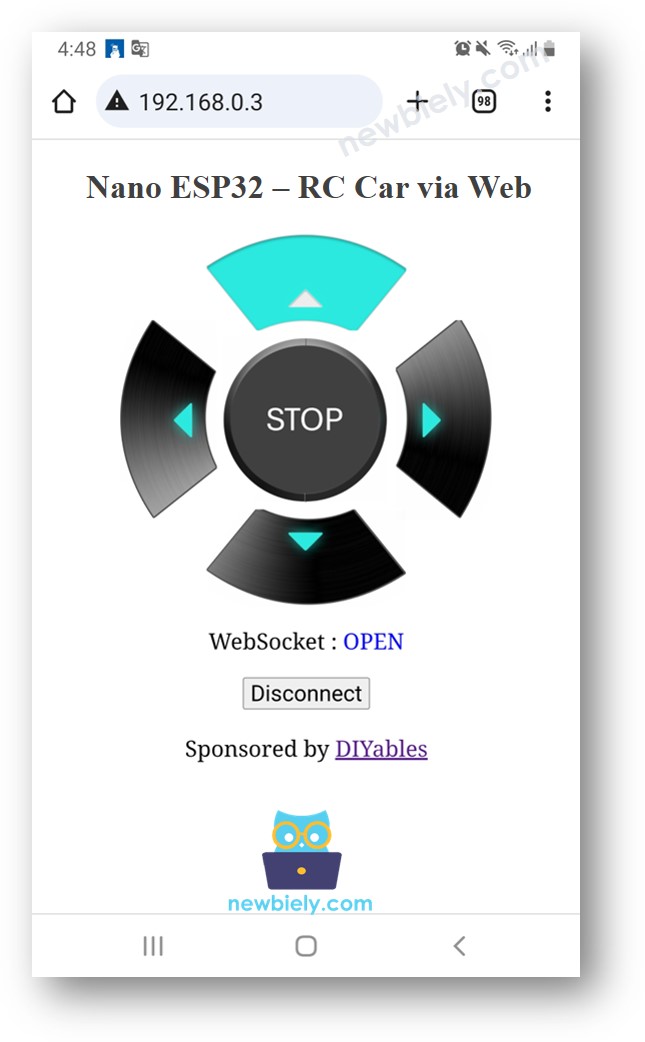Arduino Nano ESP32 - Control Car via Web
This guide shows you how to use the Arduino Nano ESP32 to wirelessly control a robot car from a Web browser on your smartphone or PC using WiFi. The control is facilitated through a graphical web user interface using something called WebSocket, allowing for smooth and dynamic control of the car.
Or you can buy the following kits:
Disclosure: Some of the links provided in this section are Amazon affiliate links. We may receive a commission for any purchases made through these links at no additional cost to you.
Additionally, some of these links are for products from our own brand,
DIYables .
Now, why go for WebSocket? Here's the scoop:
Without WebSocket, changing the car's direction would require reloading the page every time. Not ideal!
However, with WebSocket, we establish a special connection between the webpage and the Arduino Nano ESP32. This enables sending commands to the Arduino Nano ESP32 in the background, without needing to reload the page. The result? The robot car moves seamlessly and in real-time. Pretty cool, right?
In a nutshell, the WebSocket connection enables the smooth, real-time control of the robot.
We have specific tutorials about 2WD RC Car and WebSocket. Each tutorial contains detailed information and step-by-step instructions about hardware pinout, working principle, wiring connection to ESP32, Arduino Nano ESP32 code... Learn more about them at the following links:
The Arduino Nano ESP32 code creates both a web server and a WebSocket Server. Here's how it works:
When you enter the ESP32's IP address in a web browser, it requests the webpage (User Interface) from the Arduino Nano ESP32.
The ESP32's web server responds by sending the webpage's content (HTML, CSS, JavaScript).
Your web browser then displays the webpage.
The JavaScript code within the webpage establishes a WebSocket connection to the WebSocket server on the Arduino Nano ESP32.
Once this WebSocket connection is established, if you press/release the buttons on the webpage, the JavaScript code quietly sends the commands to the Arduino Nano ESP32 through this WebSocket connection in the background.
The WebSocket server on the ESP32, upon receiving the commands, controls the robot car accordingly.
The below table show commands list that the webpage sends to Arduino Nano ESP32 based on the user's actions:
| User's Action | Button | Command | Car Action |
|---|
| PRESS | UP | 1 | MOVE FORWARD |
| PRESS | DOWN | 2 | MOVE BACKWARD |
| PRESS | LEFT | 4 | TURN LEFT |
| PRESS | RIGHT | 8 | TURN RIGHT |
| PRESS | STOP | 0 | STOP |
| RELEASE | UP | 0 | STOP |
| RELEASE | DOWN | 0 | STOP |
| RELEASE | LEFT | 0 | STOP |
| RELEASE | RIGHT | 0 | STOP |
| RELEASE | STOP | 0 | STOP |
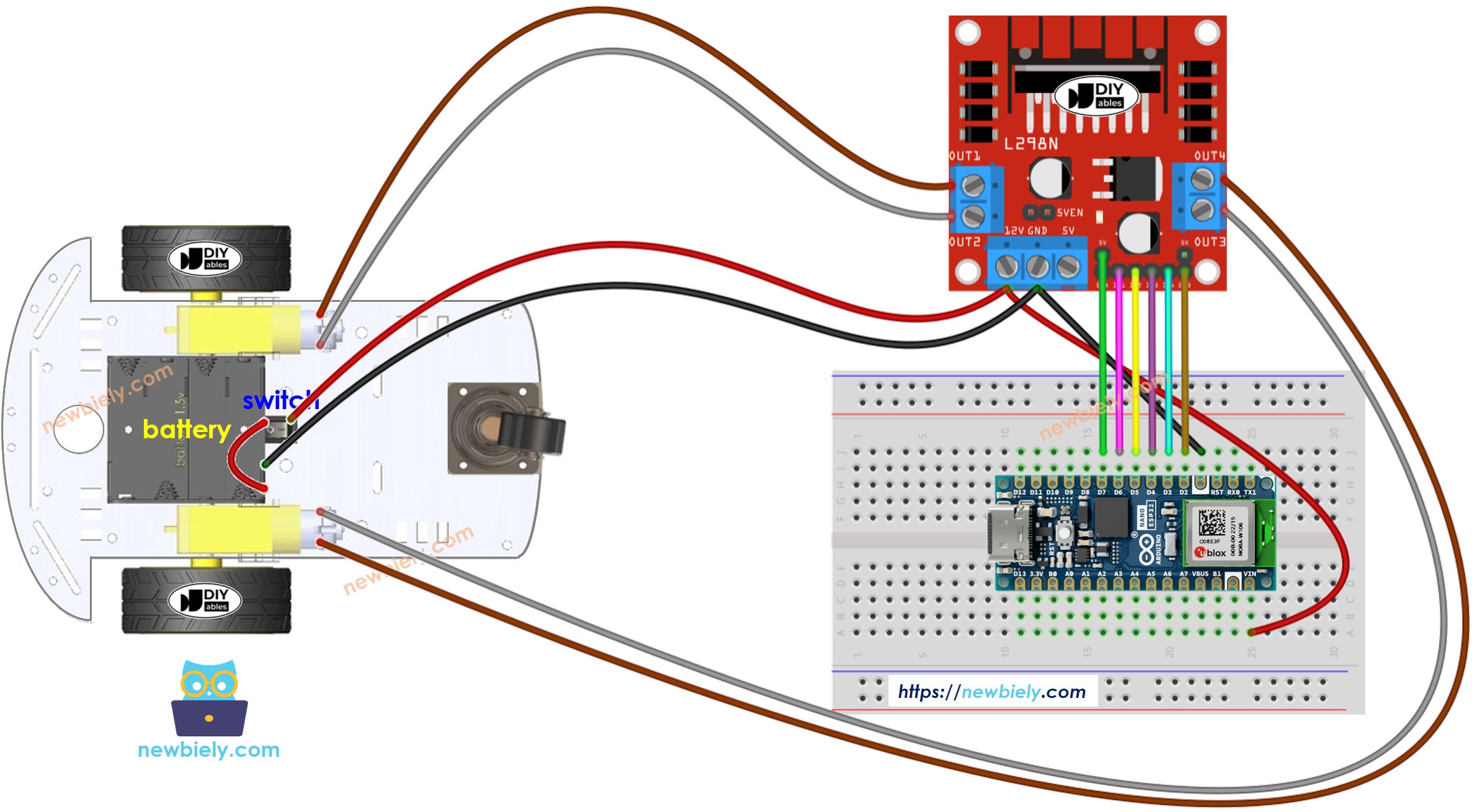
This image is created using Fritzing. Click to enlarge image
Typically, you need two power sources:
One for the motor via the L298N module.
Another for the Arduino Nano ESP32 board, L298N module (Motor driver).
But, you can simplify it using just one power source for everything – four 1.5V batteries (totaling 6V). Here's how:
Connect the batteries to the L298N module as shown.
Remove all of three jumpers from ENA and ENB pins from 5 volts on the L298N module.
Do the wiring as the above diagram.
Since the 2WD RC car has an on/off switch, you can optionally connect the battery via the switch to enable turning on/off power for the car. If you want to make it simple, just ignore the switch.
The webpage's content (HTML, CSS, JavaScript) are stored separately on an index.h file. So, we will have two code files on Arduino IDE:
An .ino file that is Arduino Nano ESP32 code, which creates a web sever and WebSocket Server, and controls car
An .h file, which contains the webpage's content.
To get started with Arduino Nano ESP32, follow these steps:
Wire the components according to the provided diagram.
Connect the Arduino Nano ESP32 board to your computer using a USB cable.
Launch the Arduino IDE on your computer.
Select the Arduino Nano ESP32 board and its corresponding COM port.
Open the Library Manager by clicking on the Library Manager icon on the left navigation bar of Arduino IDE.
Search “DIYables ESP32 WebServer”, then find the Web Server library created by DIYables.
Click Install button to install the Web Server library.
On Arduino IDE, create new sketch, Give it a name, for example, newbiely.com.ino
Copy the below code and open with Arduino IDE
#include <DIYables_ESP32_WebServer.h>
#include "index.h"
#define CMD_STOP 0
#define CMD_FORWARD 1
#define CMD_BACKWARD 2
#define CMD_LEFT 4
#define CMD_RIGHT 8
#define ENA_PIN D7
#define IN1_PIN D6
#define IN2_PIN D5
#define IN3_PIN D4
#define IN4_PIN D3
#define ENB_PIN D2
const char WIFI_SSID[] = "YOUR_WIFI_SSID";
const char WIFI_PASSWORD[] = "YOUR_WIFI_PASSWORD";
DIYables_ESP32_WebServer server;
DIYables_ESP32_WebSocket* webSocket;
void handleHome(WiFiClient& client, const String& method, const String& request, const QueryParams& params, const String& jsonData) {
server.sendResponse(client, HTML_CONTENT);
}
void onWebSocketOpen(net::WebSocket& ws) {
Serial.println("New WebSocket connection");
const char welcome[] = "Connected to ESP32 WebSocket Server!";
}
void onWebSocketMessage(net::WebSocket& ws, const net::WebSocket::DataType dataType, const char* message, uint16_t length) {
String angle = String(message);
int command = angle.toInt();
Serial.print("command: ");
Serial.println(command);
switch (command) {
case CMD_STOP:
Serial.println("Stop");
CAR_stop();
break;
case CMD_FORWARD:
Serial.println("Move Forward");
CAR_moveForward();
break;
case CMD_BACKWARD:
Serial.println("Move Backward");
CAR_moveBackward();
break;
case CMD_LEFT:
Serial.println("Turn Left");
CAR_turnLeft();
break;
case CMD_RIGHT:
Serial.println("Turn Right");
CAR_turnRight();
break;
default:
Serial.println("Unknown command");
}
}
void onWebSocketClose(net::WebSocket& ws, const net::WebSocket::CloseCode code, const char* reason, uint16_t length) {
Serial.println("WebSocket client disconnected");
}
void setup() {
Serial.begin(9600);
delay(1000);
pinMode(ENA_PIN, OUTPUT);
pinMode(IN1_PIN, OUTPUT);
pinMode(IN2_PIN, OUTPUT);
pinMode(IN3_PIN, OUTPUT);
pinMode(IN4_PIN, OUTPUT);
pinMode(ENB_PIN, OUTPUT);
digitalWrite(ENA_PIN, HIGH);
digitalWrite(ENB_PIN, HIGH);
Serial.println("Arduino Nano ESP32 Web Server and WebSocket Server");
server.addRoute("/", handleHome);
server.begin(WIFI_SSID, WIFI_PASSWORD);
webSocket = server.enableWebSocket(81);
if (webSocket != nullptr) {
webSocket->onOpen(onWebSocketOpen);
webSocket->onMessage(onWebSocketMessage);
webSocket->onClose(onWebSocketClose);
} else {
Serial.println("Failed to start WebSocket server");
}
}
void loop() {
server.handleClient();
server.handleWebSocket();
}
void CAR_moveForward() {
digitalWrite(IN1_PIN, HIGH);
digitalWrite(IN2_PIN, LOW);
digitalWrite(IN3_PIN, HIGH);
digitalWrite(IN4_PIN, LOW);
}
void CAR_moveBackward() {
digitalWrite(IN1_PIN, LOW);
digitalWrite(IN2_PIN, HIGH);
digitalWrite(IN3_PIN, LOW);
digitalWrite(IN4_PIN, HIGH);
}
void CAR_turnLeft() {
digitalWrite(IN1_PIN, HIGH);
digitalWrite(IN2_PIN, LOW);
digitalWrite(IN3_PIN, LOW);
digitalWrite(IN4_PIN, LOW);
}
void CAR_turnRight() {
digitalWrite(IN1_PIN, LOW);
digitalWrite(IN2_PIN, LOW);
digitalWrite(IN3_PIN, HIGH);
digitalWrite(IN4_PIN, LOW);
}
void CAR_stop() {
digitalWrite(IN1_PIN, LOW);
digitalWrite(IN2_PIN, LOW);
digitalWrite(IN3_PIN, LOW);
digitalWrite(IN4_PIN, LOW);
}
Create the index.h file On Arduino IDE by:

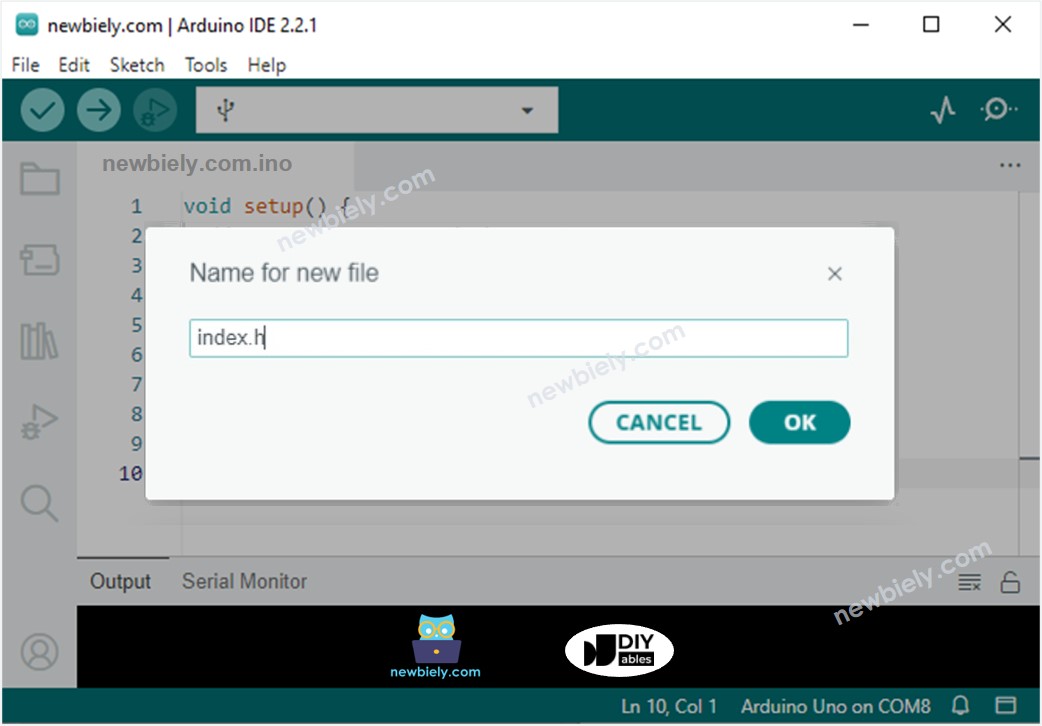
const char *HTML_CONTENT = R"=====(
<!DOCTYPE html>
<html>
<head>
<title>Arduino Nano ESP32 Control Car via Web</title>
<meta name="viewport" content="width=device-width, initial-scale=0.7, maximum-scale=1, user-scalable=no">
<style type="text/css">
body { text-align: center; font-size: 24px;}
button { text-align: center; font-size: 24px;}
#container {
margin-right: auto;
margin-left: auto;
width: 400px;
height: 400px;
position: relative;
margin-bottom: 10px;
}
div[class^='button'] { position: absolute; }
.button_up, .button_down { width:214px; height:104px;}
.button_left, .button_right { width:104px; height:214px;}
.button_stop { width:178px; height:178px;}
.button_up {
background: url('https://esp32io.com/images/tutorial/up_inactive.png') no-repeat;
background-size: contain;
left: 200px;
top: 0px;
transform: translateX(-50%);
}
.button_down {
background: url('https://esp32io.com/images/tutorial/down_inactive.png') no-repeat;
background-size: contain;
left:200px;
bottom: 0px;
transform: translateX(-50%);
}
.button_right {
background: url('https://esp32io.com/images/tutorial/right_inactive.png') no-repeat;
background-size: contain;
right: 0px;
top: 200px;
transform: translateY(-50%);
}
.button_left {
background: url('https://esp32io.com/images/tutorial/left_inactive.png') no-repeat;
background-size: contain;
left:0px;
top: 200px;
transform: translateY(-50%);
}
.button_stop {
background: url('https://esp32io.com/images/tutorial/stop_inactive.png') no-repeat;
background-size: contain;
left:200px;
top: 200px;
transform: translate(-50%, -50%);
}
</style>
<script>
var CMD_STOP = 0;
var CMD_FORWARD = 1;
var CMD_BACKWARD = 2;
var CMD_LEFT = 4;
var CMD_RIGHT = 8;
var img_name_lookup = {
[CMD_STOP]: "stop",
[CMD_FORWARD]: "up",
[CMD_BACKWARD]: "down",
[CMD_LEFT]: "left",
[CMD_RIGHT]: "right"
}
var ws = null;
function init()
{
var container = document.querySelector("#container");
container.addEventListener("touchstart", mouse_down);
container.addEventListener("touchend", mouse_up);
container.addEventListener("touchcancel", mouse_up);
container.addEventListener("mousedown", mouse_down);
container.addEventListener("mouseup", mouse_up);
container.addEventListener("mouseout", mouse_up);
}
function ws_onmessage(e_msg)
{
e_msg = e_msg || window.event;
}
function ws_onopen()
{
document.getElementById("ws_state").innerHTML = "OPEN";
document.getElementById("wc_conn").innerHTML = "Disconnect";
}
function ws_onclose()
{
document.getElementById("ws_state").innerHTML = "CLOSED";
document.getElementById("wc_conn").innerHTML = "Connect";
console.log("socket was closed");
ws.onopen = null;
ws.onclose = null;
ws.onmessage = null;
ws = null;
}
function wc_onclick()
{
if(ws == null)
{
ws = new WebSocket("ws:
document.getElementById("ws_state").innerHTML = "CONNECTING";
ws.onopen = ws_onopen;
ws.onclose = ws_onclose;
ws.onmessage = ws_onmessage;
}
else
ws.close();
}
function mouse_down(event)
{
if (event.target !== event.currentTarget)
{
var id = event.target.id;
send_command(id);
event.target.style.backgroundImage = "url('https://esp32io.com/images/tutorial/" + img_name_lookup[id] + "_active.png')";
}
event.stopPropagation();
event.preventDefault();
}
function mouse_up(event)
{
if (event.target !== event.currentTarget)
{
var id = event.target.id;
send_command(CMD_STOP);
event.target.style.backgroundImage = "url('https://esp32io.com/images/tutorial/" + img_name_lookup[id] + "_inactive.png')";
}
event.stopPropagation();
event.preventDefault();
}
function send_command(cmd)
{
if(ws != null)
if(ws.readyState == 1)
ws.send(cmd + "\r\n");
}
window.onload = init;
</script>
</head>
<body>
<h2>Arduino Nano ESP32 - RC Car via Web</h2>
<div id="container">
<div id="0" class="button_stop"></div>
<div id="1" class="button_up"></div>
<div id="2" class="button_down"></div>
<div id="8" class="button_right"></div>
<div id="4" class="button_left"></div>
</div>
<p>
WebSocket : <span id="ws_state" style="color:blue">closed</span><br>
</p>
<button id="wc_conn" type="button" onclick="wc_onclick();">Connect</button>
<br>
<br>
<div class="sponsor">Sponsored by <a href="https://amazon.com/diyables">DIYables</a></div>
</body>
</html>
)=====";
Now you have the code in two files: newbiely.com.ino and index.h
Click Upload button on Arduino IDE to upload code to Arduino Nano ESP32
Open the Serial Monitor
Check out the result on Serial Monitor.
Connecting to WiFi...
Connected to WiFi
Arduino Nano ESP32 Web Server's IP address IP address: 192.168.0.2
Take note of the IP address displayed, and enter this address into the address bar of a web browser on your smartphone or PC.
You will see the webpage it as below:
The JavaScript code of the webpage automatically creates the WebSocket connection to Arduino Nano ESP32.
Now you can control the car to turn left/right, move forward/backward via the web interface.
To save the memory of ESP32, the images of the control buttons are NOT stored on Arduino Nano ESP32. Instead, they are stored on the internet, so, your phone or PC need to have internet connection to load images for the web control page.
※ NOTE THAT:
If you modify the HTML content in the index.h and does not touch anything in newbiely.com.ino file, when you compile and upload code to ESP32, Arduino IDE will not update the HTML content.
To make Arduino IDE update the HTML content in this case, make a change in the newbiely.com.ino file (e.g. adding empty line, add a comment....)
The above Arduino Nano ESP32 code contains line-by-line explanation. Please read the comments in the code!
